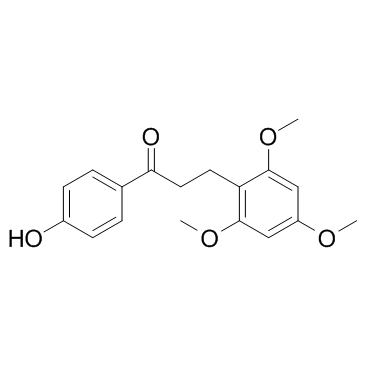Loureirin B
Modify Date: 2024-01-02 20:44:38

Loureirin B structure
|
Common Name | Loureirin B | ||
|---|---|---|---|---|
| CAS Number | 119425-90-0 | Molecular Weight | 316.348 | |
| Density | 1.2±0.1 g/cm3 | Boiling Point | 509.9±50.0 °C at 760 mmHg | |
| Molecular Formula | C18H20O5 | Melting Point | N/A | |
| MSDS | N/A | Flash Point | 184.0±23.6 °C | |
Use of Loureirin BLoureirin B, a flavonoid extracted from Dracaena cochinchinensis, is an inhibitor of plasminogen activator inhibitor-1 (PAI-1), with an IC50 of 26.10 μM; Loureirin B also inhibits KATP, the phosphorylation of ERK and JNK, and has anti-diabetic activity. |
| Name | 1-(4-hydroxyphenyl)-3-(2,4,6-trimethoxyphenyl)propan-1-one |
|---|---|
| Synonym | More Synonyms |
| Description | Loureirin B, a flavonoid extracted from Dracaena cochinchinensis, is an inhibitor of plasminogen activator inhibitor-1 (PAI-1), with an IC50 of 26.10 μM; Loureirin B also inhibits KATP, the phosphorylation of ERK and JNK, and has anti-diabetic activity. |
|---|---|
| Related Catalog | |
| Target |
PAI-1:26.1 μM (IC50) KATP ERK JNK |
| In Vitro | Loureirin B enhances the relative mRNA level of Pdx-1 and MafA. Loureirin B (1, 0.1, and 0.01 µM) increases insulin secretion in Ins-1 cells. Loureirin B (0.01 µM) almost causes no toxicity on cells. Loureirin B improves the level of expressions of MafA and Pdx-1 and ATP level. Loureirin B inhibits the KATP current but increases the [Ca2+]i level in Ins-1 cells[1]. Loureirin B inhibits the expression of Col1 and FN, as well as the TGF-β1-mediated up regulation of p-JNK. Loureirin B also inhibits the up regulation of p-ERK that is induced by TGF-β1. Moreover, Loureirin B inhibits the contraction of TGF-β1-stimulated fibroblasts through the down regulation of p-ERK and p-JNK. However, Loureirin B does not suppress the up regulation of p-p38 that is induced by TGF-β1[2]. Loureirin B downregulates both mRNA and protein levels of type I collagen, type III collagen and α-smooth muscle actin in a dose dependent manner in HS fibroblasts. Loureirin B also suppresses fibroblast proliferative activity and redistributes cell cycle, but does not affect cell apoptosis[3]. |
| In Vivo | Loureirin B significantly improves the arrangement and deposition of collagen fibres, decreases protein levels of ColI, ColIII and α-SMA and suppresses myofibroblast differentiation and scar proliferative activity, in a rabbit ear scar model. Loureirin B effectively inhibits TGF-β1-induced upregulation of ColI, ColIII and α-SMA levels, myofibroblast differentiation and the activation of Smad2 and Smad3, in NS fibroblasts[3]. |
| Cell Assay | Ins-1 cells are seeded onto 96-well plates and cultured for 48 h to approximately 80-90% confluence. Then, the cells are starved in a 2% FBS/DMEM for 12 h. Control group is cultured in medium without loureirin B, while the positive control group is received fresh medium with glimepiride. After the treatment of loureirin B and glimepiride for 4 and 8 h, the cell viability is measured by Cell Counting Kit-8 (CCK-8). |
| Animal Admin | For short, 10 adult New Zealand white male rabbits (2.0-2.5 kg b.w./each) are acclimated and housed under the standard 12-h light: 12-h dark cycle with free access of water and SPF basal diet. Rabbit is first anaesthetized with 1% pentobarbital (1.5 mg/kg b.w.), and then, a dermal punch biopsy (10×4 mm) is created down to bare cartilage on the ventral surface of each ear to outline a full-thickness wound. Four punch wounds are made on each ear of the eight rabbits. A dissecting microscope is used to ensure the complete removal of epidermis, dermis and perichondrium in each wound. Forty-eight hours after surgery, wounded rabbits are randomLy divided into two groups with each being subcutaneously injected with DMSO solution (0.125% in PBS, 0.25 mL/kg b.w.) on the left ear or loureirin B solution (25 μg/mL in PBS, 0.25 mL/kg b.w.) on the right ear once every other day for total six times. Two rabbits are used for pilot experiment, four rabbits are sacrificed 14 days after injury (n = 4), and the rest four are sacrificed 28 days after injury (n=4). Two of the four scar tissues on the same ear are processed for Western blot, and the other two are used for Masson staining. |
| References |
| Density | 1.2±0.1 g/cm3 |
|---|---|
| Boiling Point | 509.9±50.0 °C at 760 mmHg |
| Molecular Formula | C18H20O5 |
| Molecular Weight | 316.348 |
| Flash Point | 184.0±23.6 °C |
| Exact Mass | 316.131073 |
| PSA | 64.99000 |
| LogP | 2.98 |
| Vapour Pressure | 0.0±1.4 mmHg at 25°C |
| Index of Refraction | 1.564 |
| Storage condition | -20℃ |
| 1-Propanone,1-(4-hydroxyphenyl)-3-(2,4,6-trimethoxyphenyl) |
| 1-Propanone, 1-(4-hydroxyphenyl)-3-(2,4,6-trimethoxyphenyl)- |
| Loureirin B |
| LR-B |
| 1-(4-Hydroxyphenyl)-3-(2,4,6-trimethoxyphenyl)-1-propanone |
| 1-(4-Hydroxyphenyl)-3-(2,4,6-trimethoxyphenyl)propan-1-one |

